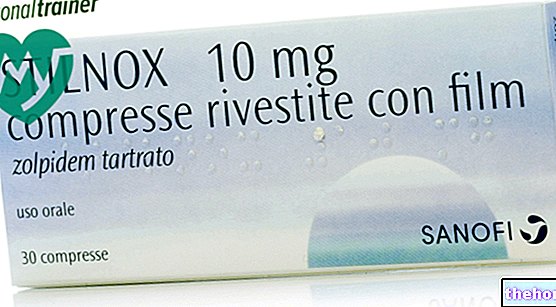Active ingredients: Nafazolin
RINAZINA 100 mg / 100 ml NASAL SPRAY, SOLUTION
Rinazina package leaflets are available for pack sizes:- RINAZINA 100 mg / 100 ml NASAL SPRAY, SOLUTION
- RINAZINA 1 MG / ML NASAL DROPS, SOLUTION
Why is Rinazina used? What is it for?
WHAT IS IT
RINAZINA NASAL SPRAY is a decongestant for nasal use.
WHY IT IS USED
RINAZINA NASAL SPRAY is indicated as a nasal decongestant in acute catarrhal rhinitis and pharyngitis, allergic rhinitis, acute sinusitis.
Contraindications When Rinazina should not be used
Hypersensitivity to the active substance or to any of the excipients. Severe heart disease and high blood pressure. Glaucoma. Hyperthyroidism.
The medicine should not be taken by children under the age of 12.
Do not administer during and in the two weeks following therapy with antidepressant drugs.
Precautions for use What you need to know before taking Rinazina
Use with caution in the elderly and in subjects suffering from prostatic hypertrophy due to the danger of urinary retention.
Interactions Which drugs or foods can modify the effect of Rinazina
The drug may interact with antidepressant medications (see When it should not be used). Tell your doctor or pharmacist if you have recently taken any other medicines, even those without a prescription.
Warnings It is important to know that:
In patients with cardiovascular diseases, especially those with hypertension, the use of nasal decongestants must in any case be subjected to the judgment of the physician from time to time.
The prolonged use of vasoconstrictors can alter the normal function of the mucous membrane of the nose and paranasal sinuses, also inducing addiction to the drug. Repeating applications for a long period of time can be harmful.
Benzalkonium chloride (BAC) contained as a preservative in RINAZINA SPRAY NASALE, especially when used for long periods, can cause swelling of the nasal mucosa. If such a reaction (persistent nasal congestion) is suspected, a BAC-free nasal medicine should be used if possible. If such nasal medications without BAC are not available, another pharmaceutical form should be considered. May cause bronchospasm.
The use, especially if prolonged, of topical products can give rise to sensitization phenomena; in this case it is necessary to interrupt the treatment and, if necessary, to institute a suitable therapy. case of sudden onset of severe headache.
When it can be used only after consulting your doctor
During pregnancy and breastfeeding (see What to do during pregnancy and breastfeeding).
What to do during pregnancy and breastfeeding
Ask your doctor or pharmacist for advice before taking any medicine. During pregnancy and lactation, RINAZINA NASAL SPRAY should only be used after consulting your doctor and evaluating with him the risk / benefit ratio in your case.
Consult your doctor if you suspect pregnancy or wish to plan a maternity leave.
Effects on ability to drive and use machines
There are no known undesirable effects on the ability to drive or use machines.
For those who carry out sporting activities: the use of the drug without therapeutic necessity constitutes doping and can in any case determine positive anti-doping tests.
Dose, Method and Time of Administration How to use Rinazina: Posology
How many
1-2 sprays in each nostril, 2-3 times a day.
Pediatric population
The drug is contraindicated in children under the age of 12 (see When it should not be used).
Strictly adhere to the recommended doses. A higher dosage of the product even if taken topically and for a short period of time can give rise to serious systemic effects.
When and for how long
If there is no complete therapeutic response within a few days, consult your doctor; in any case, the treatment should not be continued for more than a week.
Consult your doctor if the disorder occurs repeatedly or if you have noticed any recent changes in its characteristics.
Like
- If the bottle is new, press the dispenser two or three times, without introducing into the nostrils, in order to fill the pump.
- Keep the bottle upright; insert its tip into the nostril and press with rapid and firm motion during an inhalation after blowing the nose.
For subsequent applications, follow the instructions in point 2).
Overdose What to do if you have taken too much Rinazine
The product, if accidentally ingested or if used for a long time in excessive doses, can cause toxic phenomena. It should be kept out of the reach of children as accidental ingestion can cause marked sedation.
In case of overdose, arterial hypertension, tachycardia, photophobia, intense headache, chest tightness, and, in children, hypothermia and severe depression of the central nervous system with marked sedation may appear, requiring the adoption of adequate emergency measures.
In case of accidental intake of an excessive dose of RINAZINA NASAL SPRAY, notify your doctor immediately or go to the nearest hospital.
If you have any questions about the use of Rinazina NASAL SPRAY, ask your doctor or pharmacist.
Side Effects What are the side effects of Rinazina
Like all medicines, RINAZINE NASAL SPRAY can cause side effects, although not everybody gets them.
The product can locally determine rebound phenomena of sensitization and congestion of the mucous membranes. For rapid absorption of naphazoline through the inflamed mucous membranes, systemic effects can occur consisting of arterial hypertension, reflex bradycardia, headache, urination disturbances.
These side effects are usually transient. However, when they occur, it is advisable to consult your doctor or pharmacist.
Compliance with the instructions contained in the package leaflet reduces the risk of undesirable effects.
If any of the side effects gets serious, or if you notice any side effects not listed in this leaflet, please inform your doctor or pharmacist.
Request and fill in the undesirable effects report form available at the pharmacy (Form B).
Expiry and Retention
Expiry: see the expiry date indicated on the package.
The expiry date refers to the product in intact packaging, correctly stored.
Warning: do not use the medicine after the expiry date indicated on the package.
This medicine does not require any special storage conditions. Keep this medicine out of the sight and reach of children.
Do not accept the product if the bottle closure is not intact.
Medicines should not be disposed of via wastewater or household waste. Ask your pharmacist how to dispose of medicines you no longer use. This will help protect the environment.
It is important to always have the information about the medicine available, so keep both the box and the package leaflet.
Composition and pharmaceutical form
COMPOSITION
1 ml of solution contains:
Active ingredient: naphazoline nitrate 1 mg, equal to naphazoline 0.77 mg.
Excipients: sodium chloride, disodium edetate, monobasic sodium phosphate dihydrate, concentrated phosphoric acid, benzalkonium chloride, balsamic flavor, purified water.
HOW IT LOOKS
RINAZINA NASAL SPRAY comes in the form of a spray solution for nasal use. The content of the bottle is equal to 15 ml.
Source Package Leaflet: AIFA (Italian Medicines Agency). Content published in January 2016.The information present may not be up-to-date.
To have access to the most up-to-date version, it is advisable to access the AIFA (Italian Medicines Agency) website. Disclaimer and useful information.
01.0 NAME OF THE MEDICINAL PRODUCT
RINAZINA
02.0 QUALITATIVE AND QUANTITATIVE COMPOSITION
1 ml of solution contains:
Active principle:
naphazoline nitrate 1 mg.
For the full list of excipients, see section 6.1.
03.0 PHARMACEUTICAL FORM
Nasal drops, solution: clear and colorless aqueous solution.
Nasal spray, solution: clear and colorless aqueous solution.
04.0 CLINICAL INFORMATION
04.1 Therapeutic indications
Nasal decongestant in acute catarrhal rhinitis and pharyngitis, allergic rhinitis, acute sinusitis.
04.2 Posology and method of administration
Nasal drops:
Adults: 2-3 drops in each nostril, 2-3 times a day.
Nasal spray:
Adults: 1-2 sprays in each nostril, 2-3 times a day.
Pediatric population:
The medicinal product is contraindicated in children under 12 years of age (see section 4.3).
Strictly adhere to the recommended doses. A higher dosage of the product even if taken topically and for a short period of time can give rise to serious systemic effects.
If there is no complete therapeutic response within a few days, consult your doctor; in any case, the treatment should not be continued for more than a week.
04.3 Contraindications
Hypersensitivity to the active substance or to any of the excipients. Severe heart disease and high blood pressure. Glaucoma. Hyperthyroidism.
The medicine is contraindicated in children under 12 years of age.
Do not administer during and in the two weeks following therapy with antidepressant drugs.
04.4 Special warnings and appropriate precautions for use
Use with caution in the elderly and in patients with prostatic hypertrophy due to the danger of urinary retention.
In patients with cardiovascular diseases, especially those with hypertension, the use of nasal decongestants must in any case be subjected to the judgment of the physician from time to time.
The prolonged use of vasoconstrictors can alter the normal function of the mucous membrane of the nose and paranasal sinuses, also inducing addiction to the drug. Repeating applications for a long period of time can be harmful.
Benzalkonium chloride (BAC) contained as a preservative in RINAZINA nasal drops and nasal spray, especially when used for long periods, can cause swelling of the nasal mucosa. If such a reaction (persistent nasal congestion) is suspected, a BAC-free nasal medicine should be used if possible. If such nasal medications without BAC are not available, another pharmaceutical form should be considered. May cause bronchospasm.
The use, especially if prolonged, of topical products can give rise to sensitization phenomena; in this case it is necessary to interrupt the treatment and, if necessary, to institute a suitable therapy.
Rare cases of posterior reversible encephalopathy / reversible cerebral vasoconstriction syndrome have been reported with the use of sympathomimetic drugs, to which naphazoline also belongs.
Symptoms reported include sudden onset of severe headache, nausea, vomiting and visual disturbances. Most cases improve or resolve within a few days with appropriate treatment. The use of naphazoline should be discontinued immediately and a physician should be consulted if signs and / or symptoms of posterior reversible encephalopathy / reversible cerebral vasoconstriction syndrome occur.
04.5 Interactions with other medicinal products and other forms of interaction
The drug can interact with antidepressant drugs.
04.6 Pregnancy and lactation
During pregnancy and lactation, RINAZINA should only be used after consulting your doctor and evaluating with him the risk / benefit ratio in your case.
04.7 Effects on ability to drive and use machines
There are no known undesirable effects on the ability to drive or use machines.
04.8 Undesirable effects
The product can locally determine rebound phenomena of sensitization and congestion of the mucous membranes. For rapid absorption of naphazoline through the inflamed mucous membranes, systemic effects can occur consisting of arterial hypertension, reflex bradycardia, headache, urination disturbances.
04.9 Overdose
The product, if accidentally ingested or if used for a long time in excessive doses, can cause toxic phenomena. It should be kept out of the reach of children as accidental ingestion can cause severe sedation. In the event of overdose, arterial hypertension, tachycardia, photophobia, severe headache, chest tightness and, in children, hypothermia and severe depression of the central nervous system may appear with marked sedation, which require the adoption of adequate emergency measures.
05.0 PHARMACOLOGICAL PROPERTIES
05.1 Pharmacodynamic properties
Pharmacotherapeutic group: respiratory system, sympathomimetics, unassociated.
ATC code: R01AA08.
Naphthylmethylmidazoline is a sympathetic-mimetic substance belonging to the group of imidazolines, with a high vasoconstrictor action.
Rinazina, applied locally, causes decongestion of the nasopharyngeal mucous membranes; its action usually takes place within a few minutes and lasts an average of 4-6 hours.
It is available in a 0.1% solution.
05.2 Pharmacokinetic properties
The prompt therapeutic response, with the remission of the characteristic symptoms, demonstrates that following local application, the product is rapidly absorbed and transferred to specific sites of action.
05.3 Preclinical safety data
In mice, the LD50 of naphazoline is 236.7 mg / kg following oral administration and 76.2 mg / kg following intraperitoneal administration; in rats, the LD50 following intraperitoneal administration is 54 mg / kg.
Preclinical data suggest that benzalkonium chloride is capable of producing a toxic effect - concentration and time dependent - on the vibrating cilia of the epithelium of the nasal mucosa, including irreversible immobility and can induce histopathological changes of the nasal mucosa.
06.0 PHARMACEUTICAL INFORMATION
06.1 Excipients
RINAZINE 1 mg / ml nasal drops, solution:
sodium chloride, disodium edetate, monobasic sodium phosphate dihydrate, concentrated phosphoric acid, benzalkonium chloride, purified water.
RINAZINA 100 mg / 100 ml nasal spray, solution:
sodium chloride, disodium edetate, monobasic sodium phosphate dihydrate, concentrated phosphoric acid, benzalkonium chloride, balsamic aroma, purified water.
06.2 Incompatibility
None known.
06.3 Period of validity
3 years.
06.4 Special precautions for storage
This medicine does not require any special storage conditions.
06.5 Nature of the immediate packaging and contents of the package
RINAZINE 1 mg / ml nasal drops, solution - glass bottle, 10 ml
RINAZINA 100 mg / 100 ml nasal spray, solution - glass bottle, 15 ml
06.6 Instructions for use and handling
Unused medicine and waste derived from this medicine must be disposed of in accordance with local regulations.
07.0 MARKETING AUTHORIZATION HOLDER
GlaxoSmithKline Consumer Healthcare S.p.A. - Via Zambeletti s.n.c. - Baranzate (MI)
08.0 MARKETING AUTHORIZATION NUMBER
RINAZINA 1 mg / ml nasal drops, solution: 000590012;
RINAZINA 100 mg / 100 ml nasal spray, solution: 000590051
09.0 DATE OF FIRST AUTHORIZATION OR RENEWAL OF THE AUTHORIZATION
Last renewal: June 2010
10.0 DATE OF REVISION OF THE TEXT
August 2013























-nelle-carni-di-maiale.jpg)




